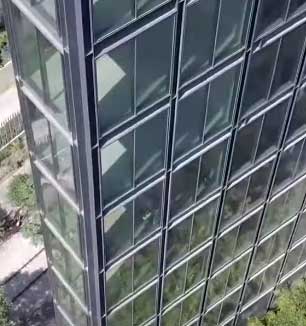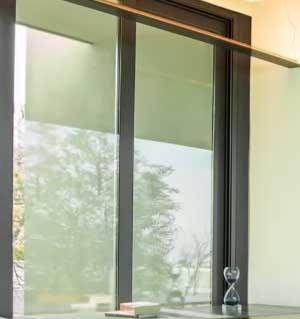When it comes to energy efficient windows, Solarban low-e (low-emissivity) glass is one of the most popular choices. Solarban glass helps reduce heat loss in winter and blocks solar heat in summer, while letting light pass through. This makes it ideal for both warm and cold climates.
Solarban 60 and Solarban 70 are two of the most commonly used types of Solarban low-e glass. But what exactly is the difference between Solarban 60 and 70? And how do you know which one is better for your home?
In this article, we’ll break down the key differences between Solarban 60 and Solarban 70 glass. We’ll look at the specs, benefits, cons, and ideal usage scenarios for each type.
By the end, you’ll have a clear understanding of how to choose the right Solarban low-e glass for your needs.
A Brief Comparison Table
Now let’s directly compare the specs and performance factors between Solarban 60 and Solarban 70:
| Factor | Solarban 60 | Solarban 70 |
| SHGC | 0.60 | 0.70 |
| Visible Transmittance | 81% | 81% |
| UV Blockage | 99% | 97% |
| Winter U-factor | 0.28 | 0.28 |
| Solar Heat Gain | Moderate | High |
| Ideal Climate | Mixed | Cold |
As you can see, the main difference comes down to solar heat gain coefficient. Solarban 70 transmits more solar heat compared to Solarban 60.
Both offer exceptional visibility, insulation, and UV blockage. The choice depends on your specific climate and priorities.
Solarban 60 provides a better balance of solar control for mixed climates. Solarban 70 prioritizes solar heat gain for cold northern regions.
Key Differences Between Solarban 60 And 70 Low-E Glass
Now let’s look at how Solarban 60 and 70 differ.
Solarban 60 Glass

Solarban 60 glass comes with a solar heat gain coefficient (SHGC) of 0.60.
The SHGC refers to how much heat from direct sunlight the glass transmits.
With a SHGC of 0.60, Solarban 60 glass blocks 60% of solar heat while letting 40% into the building.
This medium SHGC makes Solarban 60 a good choice for colder and mixed climates that want some solar heat gain in winter.
Here are some key specs and benefits of Solarban 60 glass:
- SHGC: 0.60
- Visible Light Transmittance: 81%
- UV Blockage: 99%
- Winter Nighttime U-factor: 0.28
- Solar Heat Gain: Moderate
- Glare Reduction: Good
- Ideal for colder and mixed climates
- Provides balance of solar control and heat gain
The moderate SHGC strikes a good balance between solar control in summer and passive solar heating in winter. Areas that experience both cold winters and warm summers can benefit from Solarban 60.
Compared to clear glass that has a SHGC near 0.86, Solarban 60 cuts solar heat gain by 30%. This can lower air conditioning costs in the cooling season.
Meanwhile, the relatively high visible light transmittance of 81% ensures plenty of natural daylighting. And a low U-factor of 0.28 provides effective insulation.
Overall, Solarban 60 offers a versatile combination of solar control, visibility, insulation, and passive solar heat gain.
Solarban 70 Glass
As the name suggests, Solarban 70 glass has a higher SHGC of 0.70 compared to Solarban 60.
With an SHGC of 0.70, Solarban 70 blocks 30% of solar heat while transmitting 70% into a building. This makes Solarban 70 ideal for colder northern climates that want maximum solar heat gain in winter.
Here are some key specs and benefits of Solarban 70 glass:

- SHGC: 0.70
- Visible Light Transmittance: 81%
- UV Blockage: 97%
- Winter Nighttime U-factor: 0.28
- Solar Heat Gain: High
- Glare Reduction: Moderate
- Ideal for colder northern climates
- Provides most solar heat gain
The 0.70 SHGC maximizes free solar heating to warm up living spaces in winter. This can help reduce heating costs in cold climates.
The tradeoff is that Solarban 70 provides less shading from direct sunlight in summer. But for climates with warmer winters and milder summers, the extra solar heat gain is often desirable.
Just like Solarban 60, Solarban 70 has a high visible light transmittance of 81% and low U-factor of 0.28 for insulation. It blocks over 97% of UV rays for protection.
Overall, Solarban 70 prioritizes solar heat gain, which makes it best suited for colder northern regions.
Pros and Cons of Solarban 60 Glass
Pros
- Good mix of solar control and heat gain for mixed climates
- Reduces summer cooling costs while still allowing winter solar gain
- Reflects 60% of solar heat for less glare and overheating
- High visible light transmittance for natural daylighting
- Excellent UV blockage protects interiors from fading
Cons
- Less winter solar heat gain compared to Solarban 70
- Not ideal for predominantly heating-dominated climates
Pros and Cons of Solarban 70 Glass
Pros
- Maximizes solar heat gain to naturally warm interiors
- Ideal for heating-dominated climates with cold winters
- Can reduce winter heating costs
- High visible light transmittance for daylighting
- Good UV blockage for protection
Cons
- Provides less shading from direct sunlight in summer
- Not ideal for cooling-dominated climates
- More glare possible compared to Solarban 60
Solarban 60 Or 70: Which Is Better?
There is no definitive “better” option between Solarban 60 and 70. The right product depends entirely on your climate and specific needs:
- For mixed climates with both cold winters and hot summers, Solarban 60 is likely the better choice. It delivers a good balance of solar control and heat gain for year-round efficiency.
- For predominantly heating-dominated climates with milder summers, Solarban 70 is likely better. It maximizes solar heat gain to warm living spaces in winter.
- For predominantly cooling-dominated climates with lots of air conditioning, Solarban 60 makes more sense. It reflects more summer solar heat to cut cooling costs.
Work with a qualified window installer to evaluate your climate and energy priorities. This will determine whether Solarban 60 or 70 is the right fit for your home. Both deliver excellent performance – you just need to choose the one aligned with your specific needs.
Solarban 60 And 70 For Homes
When choosing new windows for a home, Solarban 60 and 70 glass are both excellent options. Here are some guidelines on when to use each:
- For homes in colder climates like the northern U.S., Canada, and parts of Europe, Solarban 70 provides maximum free heating from the sun. This can noticeably reduce winter heating bills.
- In warmer southern regions and mixed climates, Solarban 60 balances solar control in summer with winter solar gain. Homeowners benefit from more moderate year-round energy usage.
- Anywhere you want to maximize natural daylighting, both Solarban 60 and 70 transmit over 80% of visible light for bright interiors.
- To protect furnishings from UV damage, Solarban glass blocks over 97% of harmful rays no matter which you choose.
Work with a professional installer to model the energy performance based on your climate and home. This will determine if Solarban 60 or 70 is the better investment for your residential windows.
Solarban 60 And 70 For Businesses
Along with homes, Solarban low-e glass also benefits commercial buildings. The same guidelines apply:
- Solarban 70 is ideal for buildings in colder northern climates to reduce heating costs. Offices, schools, hospitals, and retail stores stay warmer with maximum solar heat gain.
- Solarban 60 makes more sense for commercial buildings in southern or mixed climates needing equal solar control and heat gain. The moderate SHGC keeps buildings comfortable year-round.
- Restaurants, cafes, showrooms and any business wanting abundant natural light should choose Solarban for visibility over 80%.
- For stores selling goods vulnerable to fading, Solarban provides over 97% UV blockage for product protection.
Consult with an architectural glazier to perform energy modeling and light transmittance analysis for your commercial space. This will determine if Solarban 60 or 70 better suits the business needs.
Solarban Low-E Glass: Key Takeaways
- Solarban 60 has an SHGC of 0.60 for a good balance of solar control and heat gain in mixed climates
- Solarban 70 has an SHGC of 0.70 to maximize solar heating in cold climates
- Both have high visible light transmittance over 80% for natural daylight
- Both block over 97% of UV rays for protection from fading
- Solarban 60 is better for homes and businesses in mixed or cooling-dominated climates
- Solarban 70 is ideal for homes and businesses in predominantly heating climates
- Work with window professionals to model energy performance for your specific climate and needs
Frequently Asked Questions (FAQ)
The main difference is in the solar heat gain coefficient (SHGC). Solarban 60 has an SHGC of 0.60 while Solarban 72 has an even lower SHGC of 0.27. Solarban 72 blocks much more solar heat, making it ideal for cooling-dominated climates that want maximum shading.
No, Solarban 70 does not come with a tint. It has a visible light transmittance of 81% for high clarity. The Solarban coating itself is microscopic and does not produce any tint or color. However, tinted glass can be requested for appearance or additional solar control.
Solarban 60 is a low-emissivity coated glass with a solar heat gain coefficient of 0.60. It blocks 60% of solar heat while transmitting enough to passively warm interiors in winter. With good visibility and insulation, Solarban 60 works well in mixed climates needing equal solar control and solar heat gain.
Solarban 70 is a low-e glass with a 0.70 solar heat gain coefficient. It transmits 70% of solar heat to maximize passive solar warming in winter, making it ideal for colder northern climates. Like all Solarban products, it also provides great visibility and insulation.
Final Thoughts
Solarban 60 and Solarban 70 are both high performance low-e glasses from PPG. The key difference lies in the solar heat gain coefficient – Solarban 60 has a SHGC of 0.60 while Solarban 70 has a SHGC of 0.70.
Solarban 60 offers balanced solar control and heat gain, making it ideal for mixed climates. Solarban 70 prioritizes solar heat gain through its higher SHGC, making it better suited for heating-dominated northern climates.
Both provide great visibility, insulation, and UV protection. By choosing the right product for your climate, Solarban low-e glass can help reduce energy costs and keep homes and businesses comfortable year-round.
Consult window professionals to determine whether Solarban 60 or 70 is the better choice based on your specific location and needs.
